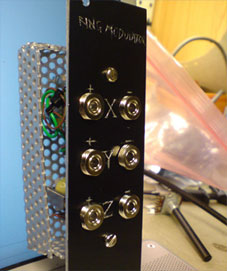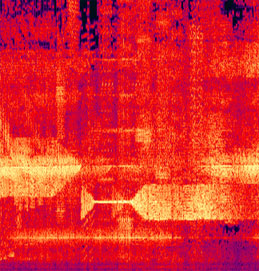Veqtor: Analogue vs Digital
November 8th, 2008

My friend Veqtor is building a modular synth, but so far he’s only got two modules, a Doepfer A-143-2 Quad Envelope and a passive ring modulator. (That I helped build) No fun? Wrong!
Listen to the sound clip in his blog post!
The envelope can be turned into an LFO by using feedback where a step in the envelope retriggers the the envelope. (Ie, “when reaching sustain, retrig”) The resulting waveform varies between triangle and sawtooth, depending on the attack and decay.
And as can be seen, the ring modulator has, not only the usual X, Y, Z, but each of them has a + and - port, totalling 6 in/outputs. This was my idea, and it works like this: When only one of the +/- ports of one group is connected, it works like a regular ringmod. When both a + and - are connected, the signal pins of the respective signal pins of those inputs are connected to the respective poles on the ring modulator. Or to put it another way, the - input is connected to where Ground would normally be connected. This is ok since the transformers make each group (X, Y, Z) electrivally isolated.
The result is that the - input is subtracted from the + input. For example, it’s interesting to route a signal with an effect on + and the same signal dry on -. (Filters and phase effects work the best) As for the output, you can, eg, connect Z+ as an output (As usual) and connect Z- as an input. We haven’t tried this yet, but I’m sure it will sound interesting…
As for Veqtor’s blog post, he goes on to discuss the difference between analogue and digital synthesis, and where each one. An analogue synth has a certain quality to it (In the neutral sense of the word) which is hard to emulate, whereas audio can be processed digitally in ways that analogue synths and effects can’t do it.
When creating the clip in the blog post, he was using, among other digital effects, PSP Nitro. I will hereby take the opportunity to say that I’ve always thought the name of this plug is a bit ironic, since PSP=Playstation Portable and Nitro is the code name that was used for Nintendo DS. Yeah, I know. That’s a very obscure thing to notice, but I had a little laugh about it when I first saw it. Of course it’s completely unintentional from their side. ![]()
![You suck at protoshop. No, you [i]really[/i] oo.](http://blog.gg8.se/images/you-suck-at-photoshop-you-really-do-your-awful.png)


